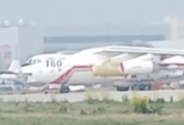Hendrik_2000
Lieutenant General
It was first observed tested in IL76 back in June 2014. So 8 years has gone by with many set back and disappointment along the way

Recently, a photo of a large bypass ratio turbofan engine was exposed on a Chinese aerial test bed. This photo shows a new engine completely different from the Russian-made D-30 engine, which was installed on an aerial test bed. According to the test, the nacelle and structure of the engine are similar to the American CFM56-7 engine and GE90 engine.
According to foreign media reports, China has imported a batch of Il-76 transport aircraft from Russia, which were converted into a batch of unknown number of engine test platforms dedicated to testing new domestic engines. China's heavy-duty strategic transport aircraft Yun 20 has no suitable domestic engines for use, so the test flight of the Yun 20 is the same as the current Il-76, equipped with D-30 engines. The aircraft exposed this time is the Il-76 test platform. The engine mounted on the inside of the left wing of this aircraft has a short and thick shape, which is obviously different from the other three relatively slender D30. It is likely to be the WS-20 (turbofan 20). Dowby turbofan engine, and WS-20 is the "genuine" engine of Yun-20.
Russia does not export more advanced engines to China
The D-30 engine is not advanced. Compared with the new-generation engine, its duct is relatively small and the fuel consumption rate is high. Russia’s newly improved Il 476 transport aircraft has replaced the D-30 with a more advanced PS-90 engine. Russian media claimed that Russia has refused to export PS-90 engines to China. The D-30 is currently China's only usable turbofan engine with no afterburner bypass ratio. The US media called the localized model WS-18. Currently, China's three main combat models: Il-76, H6K "God of War", and Yun-20 are all equipped with D-30 series engines.

Recently, a photo of a large bypass ratio turbofan engine was exposed on a Chinese aerial test bed. This photo shows a new engine completely different from the Russian-made D-30 engine, which was installed on an aerial test bed. According to the test, the nacelle and structure of the engine are similar to the American CFM56-7 engine and GE90 engine.
According to foreign media reports, China has imported a batch of Il-76 transport aircraft from Russia, which were converted into a batch of unknown number of engine test platforms dedicated to testing new domestic engines. China's heavy-duty strategic transport aircraft Yun 20 has no suitable domestic engines for use, so the test flight of the Yun 20 is the same as the current Il-76, equipped with D-30 engines. The aircraft exposed this time is the Il-76 test platform. The engine mounted on the inside of the left wing of this aircraft has a short and thick shape, which is obviously different from the other three relatively slender D30. It is likely to be the WS-20 (turbofan 20). Dowby turbofan engine, and WS-20 is the "genuine" engine of Yun-20.
Russia does not export more advanced engines to China
The D-30 engine is not advanced. Compared with the new-generation engine, its duct is relatively small and the fuel consumption rate is high. Russia’s newly improved Il 476 transport aircraft has replaced the D-30 with a more advanced PS-90 engine. Russian media claimed that Russia has refused to export PS-90 engines to China. The D-30 is currently China's only usable turbofan engine with no afterburner bypass ratio. The US media called the localized model WS-18. Currently, China's three main combat models: Il-76, H6K "God of War", and Yun-20 are all equipped with D-30 series engines.


